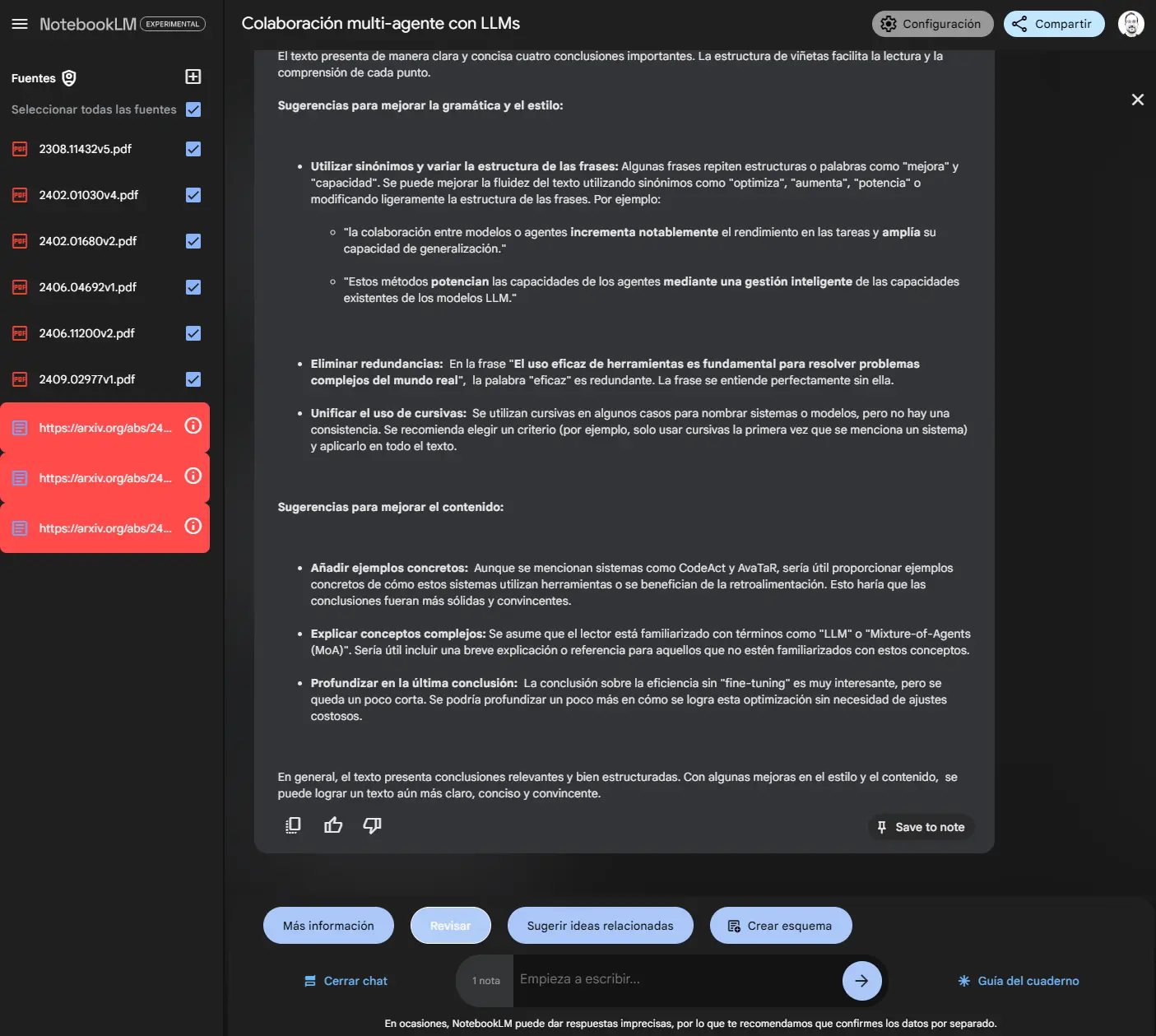
NotebookLM and Its Implications for Business AI
October 17, 2024
Talking about NotebookLM at this point might seem a bit opportunistic, given that it's currently everywhere. Google's free public application is making headlines in major tech outlets and even some general news sources. Nowadays, it would be hard to find someone who is somewhat aware of the tech world and hasn't heard of it.
However, I believe there’s still much to say about NotebookLM, especially since, as with all AI technologies, its rise to fame has coincided with the launch of a new feature that has captured the interest of both the public and the press: its ability to turn texts into a podcast. But NotebookLM is not new, and certainly is much more than just that small part of its functionality.

NotebookLM: Transforming Creativity and Productivity in the Digital Age
NotebookLM was introduced by Google nearly a year and a half ago during Google I/O 2023, under the name Project Tailwind. The name evokes the tailwinds that assist sailors in their journeys, reflecting its primary function of aiding in text composition, whether creative or otherwise. In fact, writer Steven Johnson's obsession with using software as a tool to enhance the creative process that inspired its creation.
In 2022, a team from Google Labs reached out to Johnson, also an employee atthe company, to inform him that they could build that assistant he had been searching for all his life to enhance the creative process. This collaboration between the engineers at Labs and Johnson’s writing experience gave rise to Project Tailwind, now known as NotebookLM. As often happens with AI-powered tools, the final result is capable of much more than its creators expected.
The original idea and the first iteration of its implementation were designed to assist creative writers by allowing them to consult any information from their bibliographic and documentary sources, helping them cross-check facts and identify sources, and even generate new ideas.
However, Tailwind/NotebookLM quickly emerged as a valuable tool for a broader range of users. For instance, educators and students benefit from its ability to help interpret documentary sources and facilitate the understanding of complex texts.
From my perspective, the most remarkable aspect is its entry into professional environments across various fields such as finance, marketing, and engineering, to name just a few. In all these sectors, which often deal with dense and complex sources, the tool helps organize information, find specific data and relationships, and collaborate with other professionals.

This power and versatility, along with its ability to facilitate collaboration, have led users to start sharing their notes. Meanwhile, the application has continued to add features that enhance its utility and appeal among a diverse group of professionals, enthusiasts, and individuals, such as support for YouTube videos or audio files.
The NotebookLM Revolution
However, it was in mid-September when Google added the ability to generate artificial podcasts from the information provided by the sources that caused the application’s popularity to skyrocket. And rightly so, as the results are truly impressive, with surprisingly human-like and emotionally resonant narrators conveying information in a highly effective and structured manner.
In my view, the greatest strength of NotebookLM lies not just in its capabilities but in how it puts those capabilities into the hands of everyone. Finally, the “general public” is engaging with a generative AI tool that goes beyond chatbots or image generators.
NotebookLM provides professionals and students with a mass-access tool that fulfills the promise of collaboration with artificial intelligences. It isgenuinely the dream of Steven Johnson—a “dynamic thinking partner” with the potential to enhance and streamline the creative process. It fits perfectly into the human-machine duo envisioned by advocates of a future where machines augment us rather than replace us.
New generative models have already proven to be much more than the 'stochastic parrots' their earliest critics accused them of being. They possess remarkable synthesis capabilities, the ability to relate concepts, and generalize across domains.
Beyond the initial hype, these tools offer significant productivity gains for anyone with an internet connection.They achieve this in two ways: by automating tedious tasks and by enhancing our ability to learn and understand informationthrough data correlation, summarization, and even hypothesis generation or new concept development.
For those of us working on projects to integrate this new technology into business environments, NotebookLM serves as an excellent platform for users to grasp the vast potential of these tools and to envision the possibilities when this technology gains access to all the data within their organization.
When anyone can experience the power of this technology, even on a small scale, it becomes much easier to explain its potential within the context of a larger organization. This way, it is easier to imagine that all internal company information, data in ERPs, CRMs, compliance information, employee data, shared information repository files, and metrics we measure could be accessed through a similar platform.

These platforms, like NotebookLMon a smaller scale, can amplify the potential of our employees—not replace them—by simplifying tasks and enabling them to achieve things that would otherwise be impossible. They can support every area of the business, even critical functions, allowing teams to dedicate more time to value-added tasks and less to those that are less impactful and more draining, or to undertake tasks they couldn't before.
Tasks It Can Assist With and Associated Risks
This is especially valuable for information management tasks, such as analyzing or comparing product information or streamlining operations. Consider the challenge of finding employees with the right skills and availability for a project. This would involve multiple inquiries across various systems: assignments, vacation calendars, skills databases, and even team dynamics—something these platforms can resolve automatically.
Document management also presents a significant challenge. Imagine the time spent processing countless documents: delivery notes, invoices, receipts, resumes, reports, and proposals. Instead of manually searching through documents, we could simply request the information we need from these systems. It’s easy to envision the impact on departments like Legal or Sustainability, who could quickly get answers from hundreds of pages of regulations.
However, especially in these enterprise applications, the limitations of these models necessitate the presence of skilled professionals to mitigate the risks they pose. This primarily involves their dependence on the quality of sources, privacy and security issues, lack of genuine creativity, and biases. Each of these requires thoughtful approaches and non-trivial solutions.
These technologies will compel many organizations to rethink their data strategy in what is likely to be their first truly cross-functional exploitation initiative. This will stretch the limits of data governance models or APIs in organizations where they exist and will force others to stop postponing their creation. It will necessitate a reevaluation of what data is stored and how. It will highlight the regrettable state of many data lakes, often transformed into data dumps.
Privacy and securityconcerns will require assessments and, in some cases, redesigns of these approaches, which have often been minimally designed for regulatory compliance rather than as part of a well-thought-out data protection strategy. For instance, management will want to ensure that sensitive information, such as employee bonuses, remains confidential. This issue is closely tied to data governance, further underscoring the need for a robust and comprehensive strategy.
Effective Collaboration Between Humans and AI
Althoughthese models can generate text or ideas, they lack true creativity and original thought. The solution is far from technical; it’s simply about understanding that these tools do not replace humans—let alone their understanding of the business—but rather augment them. Maximizing their potential requires a cultural effort to help the organization integrate these tools and their workflows and to train staff on their potential and proper use.
Biases pose an even greater challenge, as they are inherent to these models due to our own nature. The only valid strategies involve organizations and professionals becoming aware of these biases, learning to mitigate them within their contexts, and identifying them in external contexts.
This transformation goes far beyond mere technological implementation. It also requires a cultural shift. People need to understand these tools and their limitations and the new paradigm of human-AI collaboration. Organizations must adapt their culture and processes to leverage the strengths of humans: our contextual judgment, ability to define purpose, and capacity for creative and original thinking.
It cannot be emphasized enough that transforming people is vital for achieving meaningful change. We’re not just talking about digitizing existing processes; we’re enabling new possibilities and competitive advantages and creating new business models.
Our role in guiding organizations through this transformation is multifaceted. The teams we involve include strategy experts, technology architects, and specialists in both AI and training and culture. This requires close collaboration with key departments within organizations to ensure a cohesive and contextually relevant approach.
These projects are incredibly exciting and rewarding, as we help organizations achieve significant changes with far-reaching implications. The enthusiasm and commitment from participating departments are truly inspiring. And rightly so, as there's a sense of urgency surrounding these transformative tools. Nobody wants to be left behind.
Our latest news
Interested in learning more about how we are constantly adapting to the new digital frontier?

Insight
February 18, 2025
The Transformative Power of AI in Health and Pharma

Tech Insight
February 11, 2025
Unlocking the tech potential in international pharmaceutical tender management

Insight
February 5, 2025
Pharmaceutical tenders: top 5 obstacles and how to overcome them

Tech Insight
January 31, 2025
Galen, SNGULAR’s comprehensive generative AI solution for hospital environments
